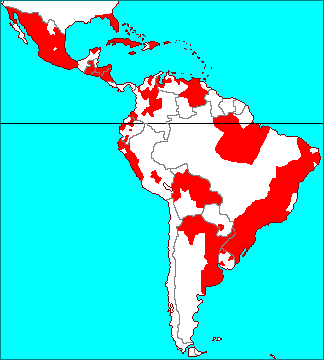
USA, México, Guatemala, Honduras, El Salvador, Nicaragua, Cuba, Bahamas, Jamaica, Dominica, Puerto Rico, Virgin islands, Leeward islands, Windward islands, Colombia, Venezuela, Ecuador, Peru, Bolivia, Brazil, Paraguay, Urguay, Argentina
USA (Florida),
México (Baja California, Sonora, Chihuahua, Nuevo León, Tamaulipas, Sinaloa, Durango, Zacatecas, San Luis Potosí, Nayarit, Aguascalientes, Jalisco, Guanajuato, Hidalgo, Veracruz, Puebla, Tlaxcala, Morelos, México, Michoacán, Colima, Guerrero, Oaxaca, Yucatán),
Guatemala, Honduras, El Salvador, Nicaragua, Cuba, Bahamas, Jamaica, Dominica, Puerto Rico, Virgin islands, Leeward islands, Windward islands,
Colombia (Magdalena, Norte de Santander, Santander, Antioquia, Boyacá, Cundinamarca, Huila, Nariño, Meta),
Venezuela (Nueva Esparta, Sucre, Monagas, Anzoátegui, Miranda, Distrito Federal, Aragua, Carabobo, Lara, Zulia, Merida, Bolívar),
Ecuador (Manabí, Carchi, Imbabura, Pichincha, Tungurahua, Azuay, Loja),
Peru (Tumbes, Piura, Cajamarca, La Libertad, Ancash, Lima, Cuzco),
Bolivia (Beni, La Paz, Santa Cruz),
Brazil (Pará, Ceará, Praíba, Pernambuco, Alagoas, Bahia, Minas Gerais, Rio de Janeiro, São Paulo, Paraná, Santa Catarina, Rio Grande do Sul),
Paraguay (Asunción),
Urguay (Cerro Largo, Artigas, Soriano),
Argentina (Jujuy, Salta, Tucumán, Formosa, Chaco, Santa Fe, Corrientes, Misiones, Entre Ríos, Buenos Aires)
0 - 3,000 m elevation
Epiphytic (Trees, Cacti, Telephone lines, Roofs, etc.), ocassionally Terrestrial
Tillandsia recurvata
Tillandsia (Diaphoranthema) recurvata (Linnaeous) Linnaeous (1762)
- [ Etymology ] recurvatus in Latin (reflexed)
- It propagates well and forms a ball-like clump.
- [ Width ] 12 - 18 cm
- [ Height ] 2.5 - 7.5 cm, Flowering 7 - 11 cm
- [ Thickness ] 3 - 10 cm
- [ Stem ] D 4 - 5 cm
- [ Petal ] Violet C80 M100 Y0 K0
- [ Bract ] Green C49 M20 Y60 K0
- [ Flower ] July, September - November
- [ Flower ] for 3 - 15 days
Classification
- [ Genus ] Tillandsia
- [ Subgenus ] Diaphoranthema
- [ Group ] recurvata
- [ Species ] recurvata
- [ Synonyms ]
- Ball moss
- Small ball moss
- Tillandsia cordobensis sensu Hassler
- Tillandsia monostachys Gillies ex Baker (1878)
- Tillandsia parasitica parva P. Browne
- Tillandsia pauciflora Sessé and Mociño (1894)
- Tillandsia recurvata var. argentea André (1889)
- Tillandsia recurvata var. brevifolia André (1889)
- Tillandsia recurvata var. caespitosa André (1889)
- Tillandsia recurvata var. ciliata Mez (1894)
- Tillandsia recurvata var. contorta André (1889)
- Tillandsia recurvata var. elongata André (1889)
- Tillandsia recurvata var. genuina André (1889)
- Tillandsia recurvata var. major André (1889)
- Tillandsia recurvata var. majuscula Mez (1894)
- Tillandsia recurvata var. minor André (1889)
- Tillandsia recurvata forma minuta (Mez ex Martius) A. Castellanos (1945)
- Tillandsia recurvata var. minuta Mez (1894)
- Tillandsia uniflora Kunth
Cultivation
Informations summarized here are based on our experiences, and TrekGEO does not guarantee the results by cultivating in the same or similar conditions described here. Even a species of Tillandsia differs substantially between individuals, and is very sensitive in changes of environments. Applicatons of any idea inspired by this site should be at your own risks.
2nd Plant
- Cultivation condition
- Partial sun, Dipping, Shelving, AC / Heater
- Nov 2025 It flowered.
- Oct 2025 Inflorescences began to grow.
- Jun 2025 Capsules opened and seeds were scattered.
- Dec 2024 Capsules began to grow.
- Nov 2024 It flowered.
- Oct 2024 Inflorescences began to grow.
- Apr 2024 Capsules opened and seeds were scattered.
- Dec 2023 Capsules began to grow.
- Nov 2023 It flowered.
- Oct 2023 Inflorescences began to grow.
- Jul 2023 Capsules opened and seeds were scattered.
- Dec 2022 Capsules began to grow.
- Nov 2022 It flowered.
- Oct 2022 Inflorescences began to grow from 2 foliages of the clump.
- Up to this point
- Partial sun, Long soaking, Shelving, Full air conditioning
- Nov 2021 It keeps growing.
- Up to this point
- Partial shade, Long soaking, Shelving, Summer AC
- Apr 2020 It keeps growing.
- Jun 2019 The capsules of 2017 opened and seeds were scattered.
- May 2019 An inflorescences began to grow.
- Sep 2018 It flowered.
- Aug 2018 Inflorescences began to grow.
- Up to this point
- Partial shade, Long soaking, Shelving, Indoors
- Apr 2018 It keeps growing.
- Dec 2017 A capsule began to grow.
- Oct 2017 It flowered.
1st Plant
- Cultivation condition
- Partial shade, Long soaking, Shelving, Indoors
- Dec 2008 It died.
- Oct 2006 Moved to another site. Cultivation condition is almost same as the previous site.
- Oct 2005 Its condition is not good.
- Jan 2005 Roots began to grow.
- Aug 2004 The temperature rises above 30 degree C for 40 days, and the highest temperature was over 39 degree C.
- Jul 2004 An inflorescence began to grow.
- Jul 2003 It flowered.